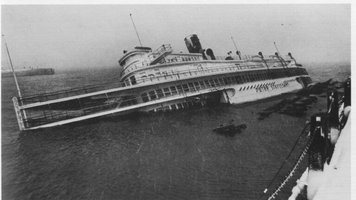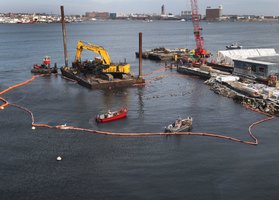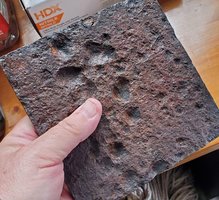-
If you enjoy the forum please consider supporting it by signing up for a NES Membership The benefits pay for the membership many times over.
-
Be sure to enter the NES/Pioneer Valley Arms February Giveaway ***Smith & Wesson SD9VE 9MM***
You are using an out of date browser. It may not display this or other websites correctly.
You should upgrade or use an alternative browser.
You should upgrade or use an alternative browser.
USS The Sullivans Taking on Water
- Thread starter FPrice
- Start date
I was at the launching of the current DDG 51 The Sullivans in Bath a few years ago.
These museum shops DO cost a lot to maintain. It wasn't that long ago the Navy was decommissioning a carrier, can't remember which one, Enterprise maybe? And Portland threw their hat in the ring for host museum city. They didn't get far though because I think the estimated yearly upkeep cost was a few million dollars.
These museum shops DO cost a lot to maintain. It wasn't that long ago the Navy was decommissioning a carrier, can't remember which one, Enterprise maybe? And Portland threw their hat in the ring for host museum city. They didn't get far though because I think the estimated yearly upkeep cost was a few million dollars.
USS Salem reopened for season. In response to questions they stated the hull is thicker, and in good shape.


Home - USS Salem CA-139 - Quincy, Massachusetts
Welcome to the U.S. Naval Shipbuilding Museum in Quincy, MA. The USS Salem is the world's only preserved Heavy Cruiser. Get your tickets online today!
www.uss-salem.org
commodon
NES Member
More info.
So if all it took was to send a few divers down to plug holes from the outside, then why did everyone wait until this ship is practically submerged to do this now? Couldn't they have sent them down last month? What am I missing?
Last edited:
Demoman
NES Member
Yea that went well for Anthony he spent a fortune having perini build a pile and timber railway for her then ballast the in side so she wouldn't float so they thought. Surge tide in blizzard of 78 lifted her it sat down in railway on its side and ripped it open and it sank. I broke up and removed the wreck a few years back for another small fortune. For the new owners of the property. They have a built life expectancy after that they are a issue that needs constant attention. If they are an issue they should be repaired or cut up so no has to risk there life trying to save them. I will cut them up free of charge line them upnot sure why these ships need to "float" in retirement?
There used to be a ship in boston harbor, next to anthonys rest,
View attachment 604808
it sat on concrete blocks. The SS Peter Stuyvesant.
Did fine until the blizzard of 78
Demoman
NES Member
Yea that went well for Anthony he spent a fortune having perini build a pile and timber railway for her then ballast the in side so she wouldn't float so they thought. Surge tide in blizzard of 78 lifted her it sat down in railway on its side and ripped it open and it sank. I broke up and removed the wreck a few years back for another small fortune. For the new owners of the property. They have a built life expectancy after that they are a issue that needs constant attention. If they are an issue they should be repaired or cut up so no has to risk there life trying to save them. I will cut them up free of charge line them up
Attachments
There’s a lot of discussion on Museum Ship groups. And it should be noted the U.S. has, by far, the most museum ships in the world and navy buffs come from all over the world to visit them.So if all it took was to send a few divers down to plug holes from the outside, then why did everyone wait until this ship is practically submerged to do this now? Couldn't they have sent them down last month? What am I missing?
The hull is 3/8” steel and hasn’t been coated for some years. The submarine USS Cod (Also in fresh water) posted this piece from her ballast tanks, made of the same material. They noted that some areas corrode faster than others.
So it’s a combination of money, unpredictable corrosion, money, lagging maintenance, money, difficulty in detection, and money. The water visibility is really bad.

Divers patch a dozen holes in USS The Sullivans Friday
Work to save the listing historic U.S.S. The Sullivans continued at the Buffalo and Erie County Naval and Military Park Friday.
Attachments
If you want to donate.
 buffalonavalpark.org
buffalonavalpark.org
Donate | Buffalo & Erie County Naval & Military Park
Make a donation to the Buffalo Naval Park online, via PayPal, or send a check in the mail. Make a donation today to benefit the future of our park!
 buffalonavalpark.org
buffalonavalpark.org
They made have just meant type of steel, not sure. It’s a Fletcher Class Destroyer, and one article notes
The shell plating is bolted and welded in strakes, or rows. Plating thickness varied from 3/4″ to 3/8″. This is why destroyers were known as “Tin Cans.”

 en.wikipedia.org
en.wikipedia.org

 www.usskidd.com
www.usskidd.com
The shell plating is bolted and welded in strakes, or rows. Plating thickness varied from 3/4″ to 3/8″. This is why destroyers were known as “Tin Cans.”

Fletcher-class destroyer - Wikipedia

Approaching the Ship - USS KIDD
As you approach the ship and come down the gangway, be certain to examine the KIDD from this vantage point. One of the first things that you will notice are her signal flags flying from the mast. The signal flags are the ship’s call letters: NYKF (from top to bottom). As all radio stations and...
rosco61
NES Member
I think they produced some 175 or there about Fletcher class Destroyers in a short 4 year span. They were war machines not expected to last a lifetime. That is just one class of ships. Think of that.

 en.wikipedia.org
en.wikipedia.org

Fletcher-class destroyer - Wikipedia
They were war machines not expected to last a lifetime.
...therein lies the problem...
I think they produced some 175 or there about Fletcher class Destroyers in a short 4 year span. They were war machines not expected to last a lifetime. That is just one class of ships. Think of that.

Fletcher-class destroyer - Wikipedia
en.wikipedia.org
...therein lies the problem...
Not really a problem. When you are producing such a large item during war time, you need to produce quantity as well as quality. You want a ship which will last for the duration of the war plus some reasonable time thereafter. It's silly to produce a destroyer that will last some 70 years and be a permanent museum piece . Not to mention prohibitively expensive. Besides, by all accounts this was an outstanding class of ship and did all that was asked of it.
The Fletcher class was a class of destroyers built by the United States during World War II. The class was designed in 1939, as a result of dissatisfaction with the earlier destroyer leader types of the Porter and Somers classes. Some went on to serve during the Korean War and into the Vietnam War.[3]
The United States Navy commissioned 175 Fletcher-class destroyers between 1942 and 1944, more than any other destroyer class, and the design was generally regarded as highly successful. The Fletchers had a design speed of 38 knots (70 km/h; 44 mph) and a principal armament of five 5-inch (130 mm) guns in single mounts with ten 21-inch (530 mm) torpedo tubes in two quintuple centerline mounts.[4] The Allen M. Sumner and Gearing classes were Fletcher derivatives.
The long-range Fletcher-class ships performed every task asked of a destroyer, from anti-submarine warfare and anti-aircraft warfare to surface action.[5] They could cover the vast distances required by fleet actions in the Pacific and served almost exclusively in the Pacific Theater of Operations during World War II, during which they accounted for 29 Imperial Japanese Navy submarines sunk.[5][failed verification] In a massive effort, the Fletchers were built by shipyards across the United States and, after World War II ended, 11 were sold to countries that they had been built to fight against: Italy, Germany, and Japan, as well as other countries, where they had even longer, distinguished careers. Three have been preserved as museum ships in the U.S. and one in Greece.

Fletcher-class destroyer - Wikipedia
Not really a problem.
The "problem" I'm referring to is the thread title, not the WWII production numbers.
rosco61
NES Member
You know what would be great? Visit and support this ship and it's right in my backyard.


Home - USS Salem CA-139 - Quincy, Massachusetts
Welcome to the U.S. Naval Shipbuilding Museum in Quincy, MA. The USS Salem is the world's only preserved Heavy Cruiser. Get your tickets online today!
www.uss-salem.org
The "problem" I'm referring to is the thread title, not the WWII production numbers.
Then you need to take that up with the OP.
I'll just warn you, I took it up with him and he told me to:
"Bugger off, mate!"
Then you need to take that up with the OP.
I'll just warn you, I took it up with him and he told me to:
"Bugger off, mate!"
You misunderstand.
The thin metal caused rapid production, but it also caused problems when these vessels are in the water for 70 years.
You misunderstand.
The thin metal caused rapid production, but it also caused problems when these vessels are in the water for 70 years.
Yes, they do.
And the title of the thread was from the first or second line of the original TV report.
Maybe the holes weren’t there last month?So if all it took was to send a few divers down to plug holes from the outside, then why did everyone wait until this ship is practically submerged to do this now? Couldn't they have sent them down last month? What am I missing?
Maybe the holes weren’t there last month?
Maybe they were in a place which was not regularly checked?
commodon
NES Member
Maybe the holes weren’t there last month?
I was under the impression the ship had been taking on water for a while and the holes didn't just appear overnight. With this impression and perhaps it is false, I would have thought proactively sending a few divers down once in a while would be routine maintenance to plug any holes. At the same time, perhaps increase the bilge output to offset the volume of incoming water?
Regardless, I am learning it's not as simple as I was thinking, and these types of things were not possible.
The concern by museum ship fans is the repair cost for the hull and recovery will make it impossible to sustain.
USS Cod, a Gato Class sub built at Electric Boat, just got a major refurbishment. Not sure how that’s controlled.
 usscod.org
usscod.org
USS Cod, a Gato Class sub built at Electric Boat, just got a major refurbishment. Not sure how that’s controlled.
USS COD HOMEPAGE
commodon
NES Member
Latest information:
Thanks for sharing




